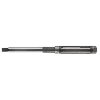Mossyrock
Member
Gents,
I have two 1851 Navy revolvers. One is a recent-production Uberti, and the other is a Second Generation Colt. While the fit and finish on the Colt are superior to the Uberti (and should be), the Uberti is considerably more accurate. That being said, the cylinder throats on the Colt measure as follows:
1. .372"
2. .373"
3. .3725"
4. .3725"
5. .373"
6. .373"
The Uberti measure a VERY consistent .3755". Based on this, it looks like I need to recut the throats of the Colt to .375". Any idea where I might be able to come up with a .375" throat reamer?
I have two 1851 Navy revolvers. One is a recent-production Uberti, and the other is a Second Generation Colt. While the fit and finish on the Colt are superior to the Uberti (and should be), the Uberti is considerably more accurate. That being said, the cylinder throats on the Colt measure as follows:
1. .372"
2. .373"
3. .3725"
4. .3725"
5. .373"
6. .373"
The Uberti measure a VERY consistent .3755". Based on this, it looks like I need to recut the throats of the Colt to .375". Any idea where I might be able to come up with a .375" throat reamer?


